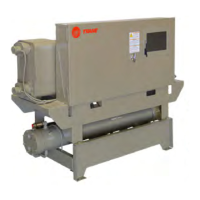Maintenance
38 CG-SVX038A-EN
Compressor Operational Noises
Because the scroll compressor is designed to
accommodate liquids (both oil and refrigerant) and solid
particles without causing compressor damage, there are
some characteristic sounds that differentiate it from those
typically associated with a reciprocating compressor.
These sounds, which are described below, are normal and
do not indicate that the compressor is defective.
At low ambient startup: When the compressor starts up
under low ambient conditions, the initial flow rate of the
compressor is low. Under these conditions, it is not
unusual to hear the compressor rattle until the suction
pressure climbs and the flow rate increases. These sounds
are normal and do NOT affect the operation or reliability of
the compressor.
Excessive Amp Draw
Excessive Amp Draw occurs either because the
compressor is operating at an abnormally high
condensing temperature OR because of low voltage at the
compressor motor.
Motor amp draw may also be excessive if the compressor
has internal mechanical damage. In this situation,
vibration and discolored oil can also be observed.
Low Suctions
Continuous low suction pressures are most likely caused
by low evaporator load coupled with a system anomaly.
Symptoms that may accompany low suctions include a
rattling sound emitted from the compressor or an open
motor winding thermostat or discharge thermostat.
Note: Operation of the chiller with saturated suction
temperatures below freezing will cause damage to
the evaporator. If this occurs immediately stop the
machine, diagnose and correct the problem.
Periodic Maintenance
Perform all of the indicated maintenance procedures at the
intervals scheduled. This will prolong the life of the unit
and reduce the possibility of costly equipment failure.
Weekly Maintenance
Once the unit has been operating for about 10 minutes and
the system has stabilized, check operating conditions and
complete the checkout procedures that follow.
• Check compressor oil levels. Oil should be visible in the
sight glass when the compressor is running. Operate
the compressors for a minimum of three to four hours
when checking oil level, and check level every
30 minutes. If oil is not at proper
level after this period,
have a qualified service representative add or remove
oil as required.
• Check suction pressure and disc
harge pressure.
• Check the liquid line sight glasses.
• If operating pressures and sight glass conditions seem
to indicate
refrigerant shortage, measure system
superheat and system sub-cooling.
• If operating conditions indicate an overcharge, slowly
(to mi
nimize oil loss) remove refrigerant at the liquid
line service valve.
• Inspect remote condenser c
oils for cleanliness (CCAR
only) and clean if required. Refer to the condenser
manufacturer’s recommendations.
Figure 7. Compressor operating map
70
80
90
100
110
120
130
140
150
-10 0 1020304050607080
Compressor Operating Map
Saturated Condensing Temperature (°F)
Saturated Evaporating Temperature (°F)

